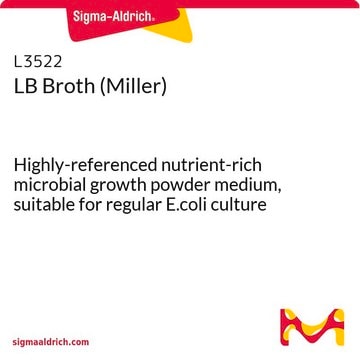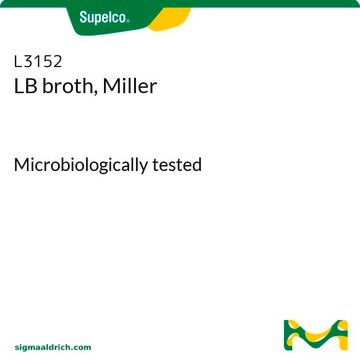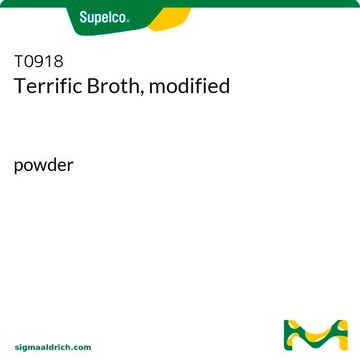L7658
LB Broth (Lennox)
EZMix powder microbial growth medium
Synonyme(s) :
Lennox broth
About This Item
Produits recommandés
Qualité
for molecular biology
Niveau de qualité
Description
quick-dissolve, dust-free formulation
Stérilité
non-sterile
Forme
powder
Technique(s)
microbiological culture: suitable
pH
6.8-7.2(2.5% solution)
Application(s)
agriculture
food and beverages
microbiology
Température de stockage
room temp
Adéquation
nonselective for Escherichia coli
nonselective for coliforms
Description générale
Application
Caractéristiques et avantages
- Granulated, dust-free format for safer handling and faster mixing
- Convenient small package to eliminate weighing
- Easy scale-up using larger package sizes
- Standard formulation
Composants
10g/L Tryptone
5 g/L Yeast Extract
5 g/L NaCl
0.6 g/L inert binder (EZMix formulation only)
Notes préparatoires
2. Autoclave for 15 minutes at 121 °C.
To prepare Lennox L Broth: Add 1 g glucose and proceed with preparation instructions as above.
To prepare the medium of Enquist and Sternberg: Aseptically add 10 ml of sterile 1M magnesium sulfate after autoclaving.
Reconstitution
Informations légales
Produit(s) apparenté(s)
Code de la classe de stockage
11 - Combustible Solids
Classe de danger pour l'eau (WGK)
WGK 2
Point d'éclair (°F)
Not applicable
Point d'éclair (°C)
Not applicable
Certificats d'analyse (COA)
Recherchez un Certificats d'analyse (COA) en saisissant le numéro de lot du produit. Les numéros de lot figurent sur l'étiquette du produit après les mots "Lot" ou "Batch".
Déjà en possession de ce produit ?
Retrouvez la documentation relative aux produits que vous avez récemment achetés dans la Bibliothèque de documents.
Les clients ont également consulté
Protocoles
General protocols for growth of competent cells in microbial medium.
Notre équipe de scientifiques dispose d'une expérience dans tous les secteurs de la recherche, notamment en sciences de la vie, science des matériaux, synthèse chimique, chromatographie, analyse et dans de nombreux autres domaines..
Contacter notre Service technique














